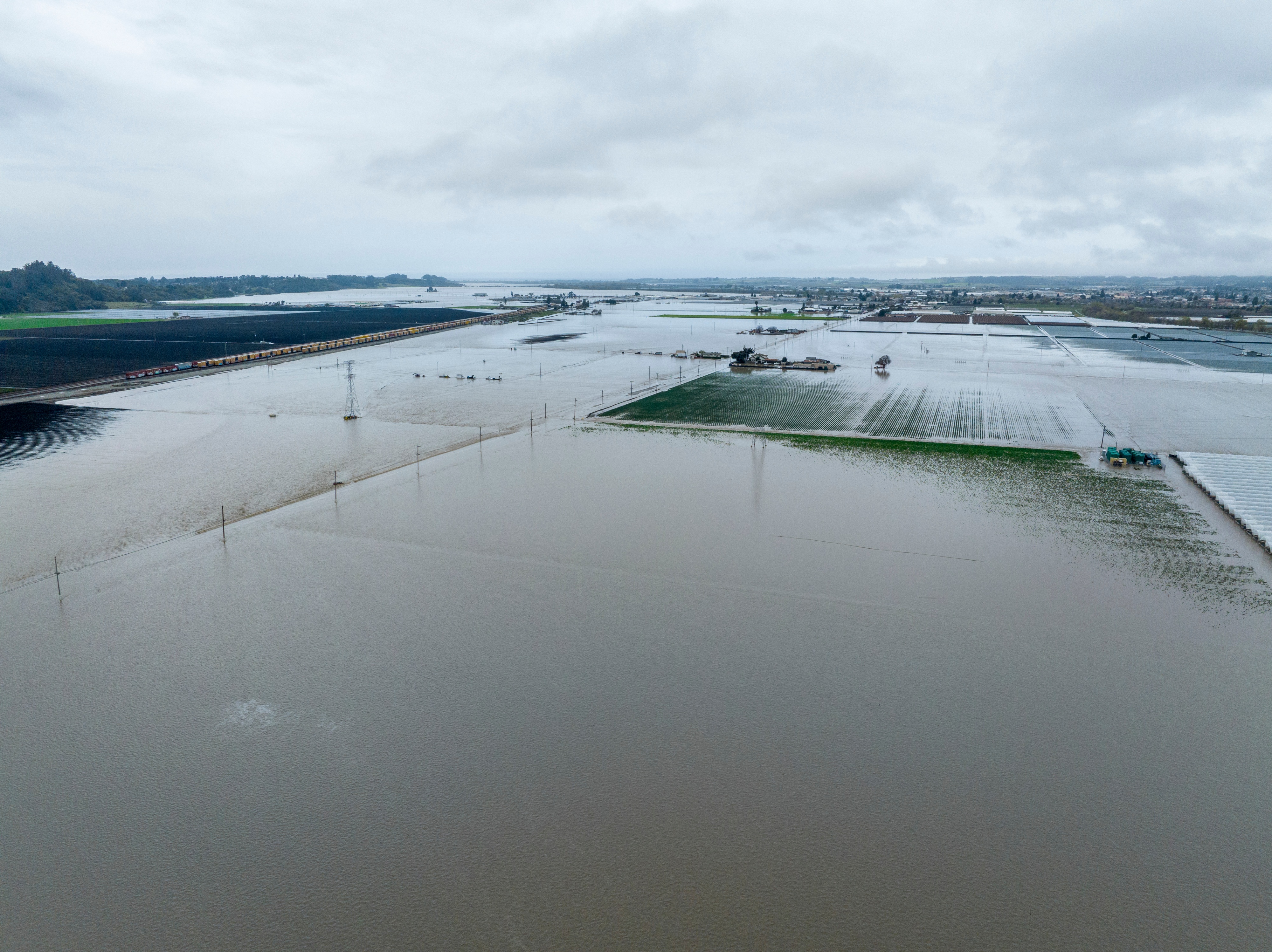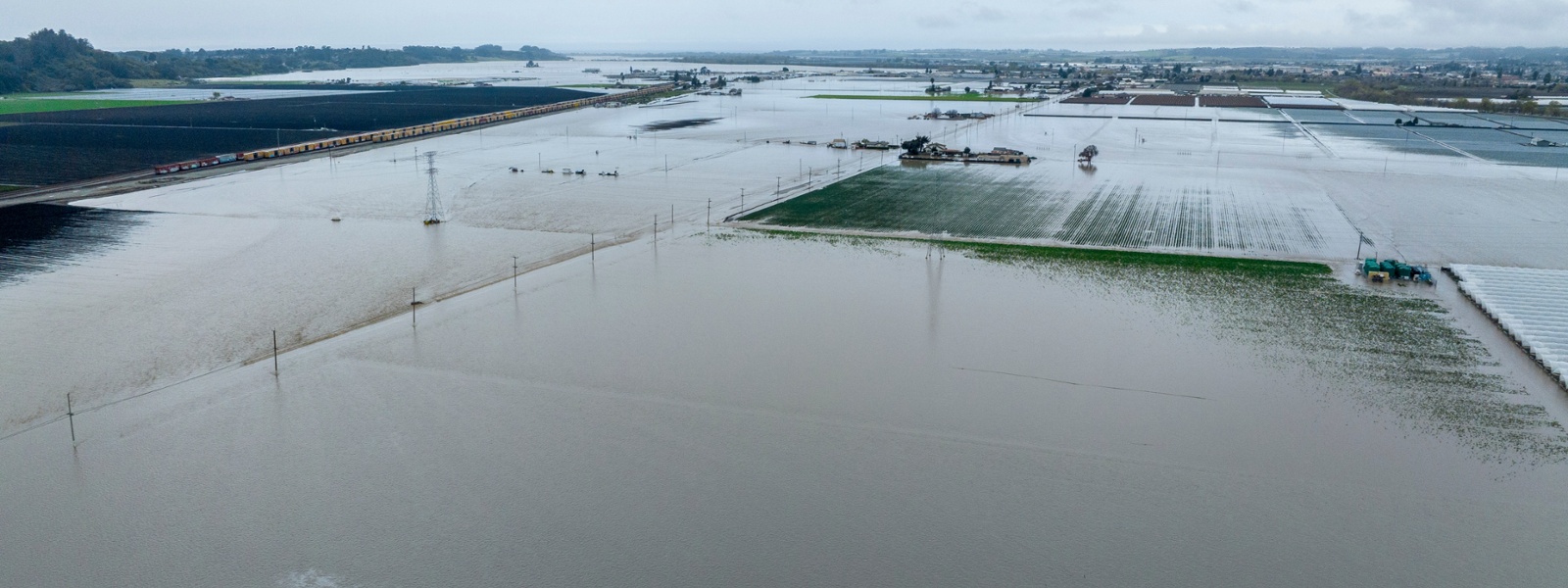Relief Act seeks to improve disaster help for farming

Floodwaters inundate farms in Monterey County after Pajaro River levee breach on March 10.
Photo / California Department of Water Resources)

By Christine Souza
To provide aid for U.S. farmers and ranchers who lost crop revenue due to unprecedented climate events, including severe drought, massive wildfires and flooding, federal lawmakers from California introduced bipartisan legislation that would create permanent disaster relief.
U.S. Sens. Alex Padilla and Dianne Feinstein, both D-Calif., and U.S. Reps. Mike Thompson, D-Napa, and Doug LaMalfa, R-Richvale, last week announced the introduction of the Agricultural Emergency Relief Act.
The legislation would create a lasting structure of the U.S. Department of Agriculture Emergency Relief Program, or ERP, to provide relief for farmers who lost crops due to natural disasters.
“Farming communities have felt impacts of climate change firsthand as drought, floods, fires and smoke have threatened their livelihoods and the economic viability of agriculture in California and across the nation,” Padilla said in a statement. “Our growers need and deserve relief quickly, and there must be a long-term solution to ensure they can get back on their feet in the face of natural disasters.”
The federal Agricultural Emergency Relief Act would require farmers who apply for relief payments to purchase crop insurance for two years after receiving a payment. In addition, payment calculations would be based on indemnities reported to USDA or on losses in revenue to better accommodate specialty crop growers.
The Act would allow Congress to appropriate supplemental disaster funds in response to the level of damage incurred in a specific year or event. Eligible disasters include droughts, wildfires, floods, hurricanes, excessive heat, excessive moisture, winter storms and freeze events.
Tulare County citrus and dairy farmer Tom Barcellos said his region, which was severely impacted by flooding this year, “would definitely be interested” in permanent disaster funding for agriculture.
“Without question, this is a tool that would have helped a lot of people this year,” he said.
In March, Barcellos and others worked in shifts to address flooding in communities downstream of the Tule River and prevent further damage in Tulare County. Many California counties were impacted by widespread flooding in January and March after rain and snowmelt overfilled rivers and creeks, displaced residents, washed out roads and damaged crops.
“I know guys that didn’t even get their second crop in their ground because their land is still under water,” Barcellos said. He added that flooding indirectly affected his business, which chops feed for other farmers.
“There’s 2,000 acres of wheat that didn’t get chopped and another 1,500 acres that they would have double cropped back to corn,” Barcellos said.
Flooded crops in the area include wheat, grapes, walnuts and other tree crops, including young trees. Barcellos said standing water on farmland prevented growers from planting subsequent crops later in the season.
Wildfires have had particular impacts on winegrape growers. Lake County farmer Dave Rosenthal said several years of devastating blazes have affected vintners in numerous winegrape-growing regions. The resulting smoke taint on crops led to rejection of grapes by many wineries.
“There are some vineyards in Lake County that got (winegrapes) rejected in 2015, 2018 and 2020,” Rosenthal said. “I ended up losing that (2020) crop, and I didn’t have crop insurance. But if something like that was available where I could get compensation and then buy crop insurance the following year or years, I would certainly do that.”
Rosenthal said researchers at the University of California, Davis, and others in the wine business are researching the effect of wildfire smoke on wine and working to develop standards to better inform when grapes should be rejected due to levels of smoke.
Matthew Viohl, federal policy director for the California Farm Bureau, said less than a quarter of the 400 agricultural commodities in California are covered by a specific crop insurance program.
He said reliance on “ad hoc” disaster programs such as ERP has been a challenge for those who need access to funding. ERP was formerly known as the Wildfire and Hurricane Indemnity Program Plus, or WHIP+.
While Congress routinely provides relief for farmers impacted by natural disasters, lack of a permanent program has resulted in multiple administrative changes, which can cause unnecessary delays in implementation and confusion for farmers.
Farmers and ranchers who experience crop losses caused by natural disasters must deal with a “complicated and lengthy process to get financial relief,” LaMalfa said in a statement.
“There are farmers in California who are still waiting on aid for losses from several growing seasons ago,” LaMalfa said. “Creating a permanent disaster program—especially for specialty crop producers—is essential to ensure family farms stay in operation and our nation’s food security is preserved.”
Federal legislation signed into law in 2021 by President Joe Biden allocated $10 billion to help agricultural producers impacted by wildfires, droughts, hurricanes, winter storms and other eligible disaster events experienced during 2020 and 2021.
As of July 30, the USDA Farm Services Agency had paid $7.4 billion of the ad hoc funding to 293,602 applicants nationwide through the Emergency Relief Program.
California received close to $374 million in ERP funds for 6,812 applicants, with $94 million for grapes, $40 million for almonds, $30 million for cherries, $20 million for rice and $19 million for cotton.
The program, Viohl said, was split into two phases, with a first phase for those who had participated in risk management programs and a second phase for those who had not previously participated. With $2.6 billion in ERP monies yet to be distributed, Viohl said he expects applications are being processed.
Viohl said Farm Bureau is pleased that members of Congress are working on additional disaster funding for agriculture. He added that the need for more support has grown in recent years as disasters such as drought, wildfires and flooding continue to negatively impact producers in the West.
“We appreciate the bipartisan and bicameral attention on disaster aid since farmers and ranchers in California rely so heavily on this, especially in the last few years,” Viohl said. “We are hopeful that crop insurance protections are expanded to help cover some of the gaps.
(Christine Souza is an assistant editor of Ag Alert. She may be contacted at csouza@cfbf.com.)




